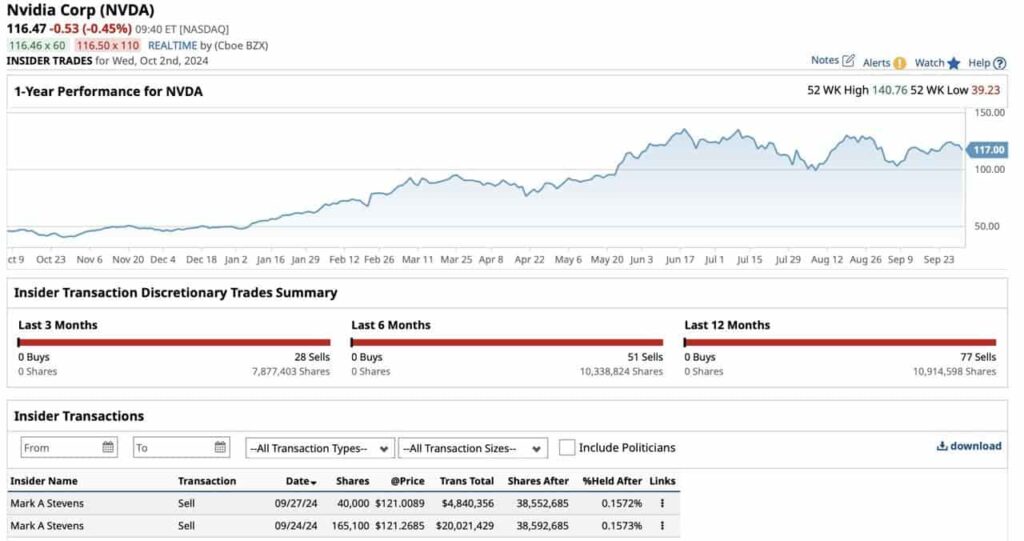An SEC filing dated October 1 reveals that billionaire venture capitalist and partner at S-Cubed Capital, Mark Stevens, a member of Nvidia’s (NASDAQ: NVDA) board of directors, has sold 40,000 Nvidia shares at a price of $121.0089.
The total value of Stevens’ transaction amounts to $4,840,356. The trade was executed on September 27 — during the course of the trading day, Nvidia’s stock price ranged from a high of $122.77 to a low of $119.35, closing at $121.03.
At press time, the stock is trading at $122.54 and is currently up 154.41% year-to-date (YTD).

Increased insider selling at Nvidia
While traders and media outlets are quick to assign any instance of insider selling as a portent of imminent doom, context ultimately serves to determine whether such transactions can be leveraged to determine price action.
That being said, Nvidia insiders have been engaging in widespread selling this year. On September 20, Chief Financial Officer Colette Kress offloaded 66,670 shares for $7.7 million, while Principal Accounting Officer Donald Robertson sold 4,500 shares, pocketing roughly $524,293.
More importantly, Nvidia’s CEO, Jensen Huang, has completed his planned sale of six million NVDA shares, generating a total of $713 million, according to Barron’s.
Are insider sales a sign of a downturn for NVDA?
With all of that in mind, none of these transactions — even taken together and accounting for their magnitude, are a sure sign that the semiconductor company is losing steam.
Most of these trades are executed via 10b5-1 plans — which must be filed in advance, typically at least three months before the sale of equity occurs. To avoid legal liability and the accusation of insider trading, board members, insiders, and company officials designate how many shares they want to sell ahead of time.
Interestingly enough, Stevens’ sale was not done in this manner — a closer look at the top left corner (specifically, the second checkbox) of the SEC filing reveals that this transaction was not executed pursuant to a 10b5-1 plan.

This is not illegal — insiders are allowed to sell shares outside of these plans, on the condition that they do not possess material non-public information (MNPI). However, these trades have to be reported to the SEC within two business days, and they attract greater scrutiny, oversight, and potential legal risks.
We wouldn’t be so quick to put the sale of 40,000 shares executed in this manner above the sale of more than 6,000,000 shares via 10b5-1 plans — particularly as insiders still hold large amounts of NVDA stock, such as CEO Jensen Huang, who still owns 75.4 million shares as well as an additional 796 million held through various trusts and partnerships.
NVDA forecasts and valuation worries
Institutional consensus is bullish regarding Nvidia — particularly with the release of the new Blackwell chip which is seeing ‘insane demand’ per CEO Jensen Huang. Others, like Rosenblatt Securities, have set price targets as high as $200, citing the company’s ambitious AI roadmap.
Dissenting opinions are present, however. Meta (NASDAQ: META) CEO Mark Zuckerberg recently expressed doubts about the long-term growth prospects of AI-focused microchip infrastructure, although he remains bullish overall.
Others are bearish on the stock — economist and financial author Harry Dent believes that a market-wide bubble has been at play for more than a decade and that the subsequent correction will see NVDA share prices decline as much as 98%, while technical analysts such as Alan Santana see the potential for a smaller, yet significant 50% drop in the near term.
Only time will tell whether theories surrounding a general bubble or an AI bubble are correct — traders and investors should turn their attention to macroeconomic factors and pay close attention to Nvidia’s next earnings report on November 19 for a more material outlook on the stock’s long-term prospects.








